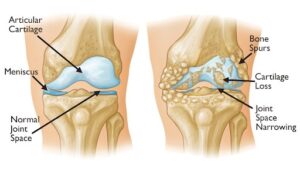Osteoarthritis is the most common form of arthritis and is caused by joint breakdown over time. There’s currently no cure, but lifestyle changes and certain treatments can help with symptoms
Osteoarthritis, or OA, is caused by chronic breakdown of the entire joint, including cartilage (the soft connective tissue “shock absorber”), tendons and ligaments (tissues connecting muscles and bones to each other), and the bone itself. As the joint wears away, bone begins to rub on bone, causing chronic low-level inflammation, scarring, and excess bone growth (osteophytes, or bone spurs) that trigger further joint destruction.

(Source; Image from the American Academy of Orthopedic Surgeons)
Osteoarthritis can affect any joint, but most commonly affects the joints of the hands, knees, hips, & spine. Multiple joints can be at different “stages” of osteoarthritis and thus have different symptoms. The most common symptoms include:
➡️ Pain during or after movement
➡️ Stiffness or loss of flexibility in the joint
➡️ Joint swelling
➡️ Popping or “creaking” sounds when moving the joint (crepitus)
➡️ Bony spurs under the skin
There are more than a hundred types of arthritis, but osteoarthritis is the most common, affecting about 4% of the global population. If all US adults over 55 were X-rayed, an estimated 8 out of 10 would have results showing signs of osteoarthritis, even if only half of them ever experience symptoms. Imaging is not always necessary to diagnose osteoarthritis, but your clinician may order X-rays, MRIs, or other lab tests to ensure your joint pain isn’t being caused by another kind of arthritis or medical condition.
Nerd Alert! 🥸
Did you know that arthritis doesn’t only affect older adults? Juvenile idiopathic arthritis (JIA) is arthritis that affects children 16 years old or younger for more than 6 weeks. It is one of the most common joint disorders in North American children, and can either go away on its own or last for a lifetime. It is a type of inflammatory arthritis where the immune system attacks the joints, similar to rheumatoid arthritis or psoriatic arthritis.
Although older age is a well-known risk factor for osteoarthritis, other factors include:
➡️ Female sex, specifically being post-menopause
➡️ Overweight or obesity
➡️ Muscle weakness
➡️ Previous injury and/or trauma to the joint, such as in high-impact sports or employment with heavy work requirements (eg. broken ankle from playing soccer, repetitive knee injuries from lifting large equipment)
➡️ Certain genetic disorders (eg. Paget’s disease, Marfan syndrome)
While osteoarthritis unfortunately can’t be reversed, the best ways to prevent it include low-impact exercise (eg. walking, swimming, cycling), maintaining a healthy, balanced diet, and protecting your joints from injury (eg. using seat belts or well-fitted sports gear). Weight loss and management of chronic conditions linked with overweight/obesity (eg. type 2 diabetes, hypertension) is especially important.
Health Equity Alert! ⚖️
There are many other factors that play a role in individual weight gain. Public health officials and clinicians are now acknowledging the effects of environment, income, and other social determinants of health on overweight/obesity. For example, individuals living in higher deprivation neighborhoods (eg. lower income, higher unemployment) were more likely to gain weight. This is why it’s so important to not only 1) avoid weight stigma, but also 2) support local organizations that help improve nutrition and physical activity in the community, especially now that many US federal & state programs like the Supplemental Nutrition Assistance Program (SNAP) are undergoing funding cuts.
For those who already have arthritis, finding the right treatment is often a matter of trial and error. Some people may need to adjust or avoid activities that make the affected joint’s symptoms worse. They may need to utilize self-help tools (eg. reachers, buttoning aids) or other assistive devices like braces or canes.
Physical and/or occupational therapists can offer tailored support to stay independent and mobile. They may prescribe muscle strengthening exercises, offer suggestions for managing symptom flare-ups, or help you find assistive devices that best fit your needs, such as creating custom shoe inserts (orthotics) to help relieve pressure off of joints.
If mechanical adjustments don’t work, most people may also be prescribed high-dose acetaminophen (Tylenol) or NSAIDs (eg. ibuprofen [Advil, Motrin], naproxen [Aleve]). These can either come as pills or topical creams/gels. While these can be helpful for people with low levels of osteoarthritis-related pain, long-term use can increase the risk of kidney and/or liver damage and gastric ulcers. Some people may get steroid (cortisone) injections directly into the joint or be prescribed opioids if the previous options don’t work. Everyone’s pain and medical history are unique, so work with your clinician to find the best treatment for you.
At the most extreme level, some people may undergo surgery to either completely replace the joint (arthroplasty) or decrease pressure on the joint (osteotomy). Most people don’t need this level of treatment. While surgery does have benefits, it also has risks that are best discussed with your clinician. Alternatively, low-dose radiation to the affected joint may be an option for those who have exhausted all other means of treatment, but it is not commonly available in the US.
No matter what treatment works best for you, maintaining mobility is important to preserve not just physical health, but social, emotional, and psychological well-being as well. Older adults who lose mobility are less likely to live at home and have higher rates of disability, disease, hospitalization, and even death. This is especially important considering that people with knee or hip osteoarthritis are at increased risk of falls, which can lead to injury, a paralyzing fear of falling, or even death [archived link].
If you or a loved one is struggling with joint pain of any kind, talk with your support network and clinician about how to best manage your pain and mobility. You may not be as mobile as you’d like to be, but there are definitely options available to help you keep moving for as much and as long as you can.
Stay smart. Stay well.
Those Nerdy Girls.
References:
Cleveland Clinic – Osteoarthritis
National Institute on Aging – Maintaining Mobility
Those Nerdy Girls – Fall Prevention


